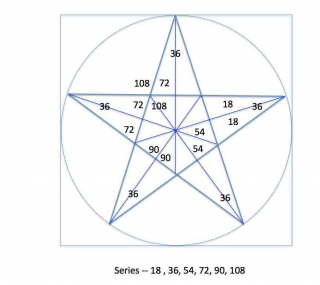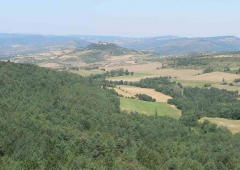The Chevauchee
On my first visit to the Languedoc in 2005, I knew nothing about Saunier or for that matter the Visigothic Treasure.
I had a completely different objective. I had learned that John Stanley, whom I believed to be an ancestor was serving with his relative Lord James Audley in the army of the Black Prince. I knew that in 1355 the Black Prince had penetrated deep into french territory in what is known as the “Grand Chevauchee” -the great cavalry charge.
 Despite there being several records of this event each record is different and there were two unexplained events.The Black Prince had a reputation of being a model of chivalry,but had burned the then new city (the Bastide) of Carcassonne. The old City (La Cité) was left untouched.
Despite there being several records of this event each record is different and there were two unexplained events.The Black Prince had a reputation of being a model of chivalry,but had burned the then new city (the Bastide) of Carcassonne. The old City (La Cité) was left untouched.
The second strange fact was that he returned with a baggage train “weighed down with treasure” I decided that I would try to visit every place mentioned as being “visited’ by the Prince in attempt to get a better understanding of what happened and where the treasure might have come from.
I quickly came to the conclusion that wherever the Black Prince’s treasure came from it was not the tiny villages mentioned in the records. With the exception of Carcassonne they are just too small to be of any significance.
Carcassonne and Limoux
Whilst visiting Carcassonne, and incidentally everyone should go there at least once, I visited Limoux, just to the south, specifically to visit the vineyards where they produce excellent sparking wine. The locals claim that the process of fermentation in the bottle was invented in Limoux and not in Champagne.

Whilst walking around the town I found a sidewalk information board which listed amongst other significant historical events the fact that the Black Prince had visited Limoux during the chevauchee and burned down “the bishops palace and some surrounding houses”
This was not recorded in any of the documentation available to me at that time. I visited the local library to seek confirmation of this event, explained the purpose of my visit and was immediately advised to visit Rennes le Château.
“If you are looking for treasure that is a place you must visit and it is not far from here”.
During that first visit, I learned about Saunier and all the different stories about his treasure. Inevitably I learned about Lincoln’s Sacred Geometry but struggled to fully understand the implications. I did not have access to IGN (French ordinance survey) maps and had not yet discovered google earth. I was totally dependant on other peoples work and there was little agreement!
Sceptical but Scientific
David Williams took a sceptical but scientific approach to every issue. He established to his own satisfaction that the pentacle established by Lincoln was in fact not perfect and attracted a lot of criticism for reaching that conclusion.
He also identified a number of other pentacles in the same area which by measurement were closer to a perfect pentacle than was the lincoln pentacle though still not “perfect”.
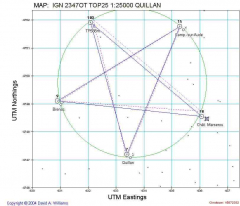 One of these, which he called the Mazerou pentacle, attracted my attention as it had a possible east west link to the Lincoln (Rennes) pentacle. I discovered that Mazerou had been one of the homes of the Trencavel family and had ultimately had passed into possession of the French Crown. It was the favoured summer residence of Blanche of Castile, widow of St Louis and then became the summer residence of the bishops of Albi.
One of these, which he called the Mazerou pentacle, attracted my attention as it had a possible east west link to the Lincoln (Rennes) pentacle. I discovered that Mazerou had been one of the homes of the Trencavel family and had ultimately had passed into possession of the French Crown. It was the favoured summer residence of Blanche of Castile, widow of St Louis and then became the summer residence of the bishops of Albi.
Return to Rennes
In the meantime Google Earth was released and I began to explore all the possible relationships. There were a number of alignments which I wanted to be true but could not be made to work on google.
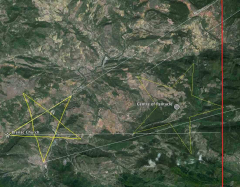 I decided that the only way to resolve these issues was to return to Rennes and make my own observations.
I decided that the only way to resolve these issues was to return to Rennes and make my own observations.
My son Steven gave me basic training in the use of a GPS and off I went, armed also with an ex army directional compass.
IGN Maps
On my arrival in Quillian the first thing I did was purchase a copy of all the IGN maps for the surrounding area.
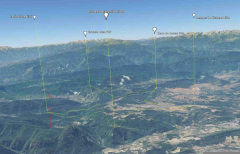
After that my first target was to visit all of the points of the Lincoln pentacle to make a personal assessment of their position.
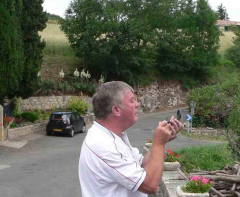
Le Pic
Whilst exploring the plain of Lauzat the one feature which cannot be missed is the ridge of limestone which suddenly culminates in a precipice known as “Le Pic”.
T
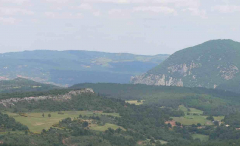 his photograph, taken from the site of the Château Bezu also shows, on the extreme left, in the middle distance Blanchefort . The dominant mountain to the right is Cardou which plays no part in the sacred geometry.
his photograph, taken from the site of the Château Bezu also shows, on the extreme left, in the middle distance Blanchefort . The dominant mountain to the right is Cardou which plays no part in the sacred geometry.
Casual observations would lead to the conclusion that this spectacular outcrop is at the centre of the pentacle. Indeed if this is indeed a miraculous topology then it should be the centre but it is not.
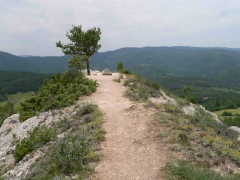 No photographs can explain the exhilaration accompanied by not a little trepidation of walking the last few steps to the edge of Le Pic.
No photographs can explain the exhilaration accompanied by not a little trepidation of walking the last few steps to the edge of Le Pic.
The Points of The Pentacle
 Nevertheless from the edge of the precipice It is possible to clearly identify without ambiguity all the points of the pentangle.
Nevertheless from the edge of the precipice It is possible to clearly identify without ambiguity all the points of the pentangle.
Château Bezu ( on top of the limestone cliff face was a templar fortress. When all the templars in France were arrested on Friday 13th october 1307, which is the origin of the superstition about Friday the 13th it is claimed that the templars of Château Bezu were the only ones not to be arrested.
I am personally not surprised. I believe that in 1307 Château Bezu was still part of the Kingdom of Majorca, who’s capital was at Perpignan. It remained a possession of Majorca until 1349 when it was absorbed by the kingdom of Aragon.
It did not become a French possession until the seventeenth century.
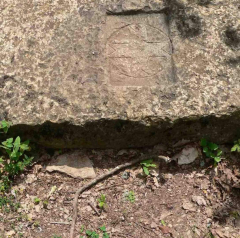 The remains of the Château cover a relatively large area so it is difficult to decide exactly where the point of the pentacle lies. I chose the templar cross carved into a step at a point where the entrance to the Château would have been.
The remains of the Château cover a relatively large area so it is difficult to decide exactly where the point of the pentacle lies. I chose the templar cross carved into a step at a point where the entrance to the Château would have been.
The view of Rennes from Le Pic shows clearly that Rennes does lie on a substantial hill. Again the village is large enough to make it difficult to decide exactly where the point of the pentacle should sit. Many others have assumed that Berenger’s tour Magdala, should be the point but in my attempts to pin down a perfect pentacle I ended up choosing the tower of Château Hautpoul, which is to the north of the village.
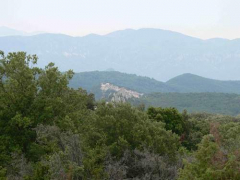 This point on the pentacle is readily recognised again for its limestone face. it is usually called Lauzat, i think because the title of Serre de Lauzat, the name of the whole plain is laid across it on the IGN map.
This point on the pentacle is readily recognised again for its limestone face. it is usually called Lauzat, i think because the title of Serre de Lauzat, the name of the whole plain is laid across it on the IGN map.This location is easy to find as the back face of the hill is where the local motocross championships are held. Note that is by no means the highest hill in its locality. The image of the sacred geometry of mountains towering above the countryside is therefore somewhat degraded. The elevations of the points of the pentacle are with the exception of Bezu dwarfed by the surrounding mountains!
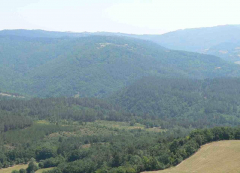 La Soulane is even more difficult to pick out against the surrounding hills. It is in fact a small hump on the side of a bigger hill. Nevertheless it is given a unique name on the IGN map. It can be identified here by the small patch of cleared ground.
La Soulane is even more difficult to pick out against the surrounding hills. It is in fact a small hump on the side of a bigger hill. Nevertheless it is given a unique name on the IGN map. It can be identified here by the small patch of cleared ground.
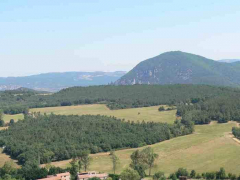 Finally Blanchfort. once again it is necessary to point out that it is Cardou on the right which dominates the middle distance. Blanchfort is on the extreme left. from this angle it appears that there is a ridge in the centre of the picture which is at least as high as Blanchefort if not higher. Google earth tells us that it is.
Finally Blanchfort. once again it is necessary to point out that it is Cardou on the right which dominates the middle distance. Blanchfort is on the extreme left. from this angle it appears that there is a ridge in the centre of the picture which is at least as high as Blanchefort if not higher. Google earth tells us that it is.
Mapping the Points
 All this was transferred to the IGN map, though here it is displayed using Google Earth. To my surprise their are differences, The pentacle looks closer to a perfect pentacle on the map. The differences are only relevant if it is essential that the points of the pentacle fall precisely on Mountain Tops and I had given that away half way through my measurements. On none of the points is it easy to say where the Mountain (Hill) top actually lies. Nevertheless the points do come close to the ideal as the enclosing circle shows.
All this was transferred to the IGN map, though here it is displayed using Google Earth. To my surprise their are differences, The pentacle looks closer to a perfect pentacle on the map. The differences are only relevant if it is essential that the points of the pentacle fall precisely on Mountain Tops and I had given that away half way through my measurements. On none of the points is it easy to say where the Mountain (Hill) top actually lies. Nevertheless the points do come close to the ideal as the enclosing circle shows.
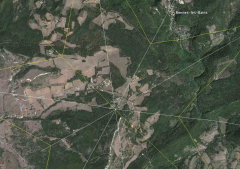 The centre of the pentacle does not lie on Le Pic in fact 600 feet to the north. I believe it could all be manipulated to be that extra 80 feet north and just off the road to Val de Dieu.
The centre of the pentacle does not lie on Le Pic in fact 600 feet to the north. I believe it could all be manipulated to be that extra 80 feet north and just off the road to Val de Dieu.
The approach of the solstace
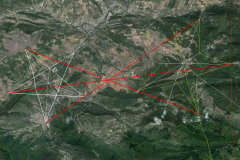 Nevertheless the solstice was approaching and I had to decide which point I would choose to observe the first rays of the sun. Relatively disappointed by the Lincoln pentacle my attention was drawn to the church at Brenac, a point on the Mazerou pentacle. Working on the IGN maps I found that simply by laying a long ruler on the maps that there were specific alignments between the Brenac pentacle and the Lincoln pentacle. I wondered if the pentacles were not “perfect” how could these alignments exist? It seemed to be that the alignments pointed towards Brenac. I paid a visit to Brenac and was astonished by what I found.
Nevertheless the solstice was approaching and I had to decide which point I would choose to observe the first rays of the sun. Relatively disappointed by the Lincoln pentacle my attention was drawn to the church at Brenac, a point on the Mazerou pentacle. Working on the IGN maps I found that simply by laying a long ruler on the maps that there were specific alignments between the Brenac pentacle and the Lincoln pentacle. I wondered if the pentacles were not “perfect” how could these alignments exist? It seemed to be that the alignments pointed towards Brenac. I paid a visit to Brenac and was astonished by what I found.

